The cave is recognized in the world as the most beautiful.
Cave systems in Phong Nha - Ke Bang Phong Nha - Ke Bang National Park (Phong Nha - Ke Bang National Park) is located in the ecological region in the northern part of the Truong Son mountain range, in Bo Trach district, Quang Binh province. Phong Nha - Ke Bang National Park is located adjacent to Hin Namno nature reserve in Kham Muon province, Laos, to the west, and 42 km east of the East Sea. It is one of the largest national parks and also the largest almost continuous limestone mountain area in Vietnam. PNKB National Park was recognized by UNESCO as a world natural heritage twice, twice in 2003 and 2015 based on two criteria: Geology - geomorphology and ecosystem - biodiversity. Phong Nha - Ke Bang is considered a giant geological museum of global value and significance

Most of the park area is limestone and is linked to the Hin Namno National Biodiversity Reserve of Laos, forming a large Karst block. This Karst block accounts for 3/4 of the Park's area, has an altitude of 300 - 1,100m, is located in the northwest of Quang Binh and extends about 100 km along the Vietnam - Laos border. The Phong Nha - Ke Bang karst area of Quang Binh has the added advantage of having water circulating through the karst terrain and many other favorable conditions to form giant karst cave systems. Areas where the cave ceiling collapses will form "sky wells" (similar to the sinkholes in Son Doong Cave or Hang Vom). Long sections of caves with collapsed ceilings will expose rivers that used to be underground streams, such as Ca Roong River, Rao Thuong River... In Vietnam there is no karst area with ideal conditions for forming caves. so much and so loud.

Therefore, thanks to the geological, geomorphological, climatic and ecological characteristics, this place has created beautiful natural scenes, typically a cave system that is both mysterious and very majestic. Up to now, within Phong Nha - Ke Bang National Park, nearly 400 different large and small caves have been discovered with a total length of 210km, linked together in 3 main cave systems: Phong Nha Cave System (total length of 103 km), Hang Vom system (48 km), and Nuoc Mooc cave system (20km). According to estimates by the British - Vietnamese Cave Exploration Group, only about 30% of the area of Phong Nha - Ke Bang National Park has been surveyed, so cave experts assess that the Phong Nha - Ke Bang National Park area There are also many hidden caves that need to be explored.
The caves belong to the Phong Nha system

Phong Nha Cave System is the longest system in the Phong Nha - Ke Bang area with a total length of more than 103km and includes more than 140 caves of different sizes.
The Phong Nha system starts about 40 km south of Phong Nha cave. Near the Vietnam-Laos border, where a series of rivers and streams flow into limestone mountains. The Phong Nha cave system was formed by the Rao Thuong river flowing through the limestone mountains, flowing underground through the valleys and connecting the caves in the Phong Nha system, then this river flows from the underground caves. straight to Son River and gradually to the big sea.
Outstanding caves in the Phong Nha system
Khe Ry Cave
The entrance to Khe Ry Cave is a dry and large cave entrance. Khe Ry Cave is considered an important part of the Phong Nha system, a water cave with a total length of more than 19 km, water flows underground through the cave and eventually emerges on the surface of a small valley outside the cave. En.
Hang En - One of the largest caves in the world
Hang En is the next largest cave in the system. There is the Thuong River that flows into and flows through Hang En before joining the water from Hang Khe Ry and flowing into Son Doong. The cave has a total length of up to 1.6km, with a ceiling height of up to 140 meters and the widest corridor up to 200 meters.

Hang Thung
The next cave in the system is Hang Thung, discovered in 1994, and is a truly unique cave of the Phong Nha cave system. Water from Hang En and Khe Ry flows through an unknown cave section and then flows into Hang Thung, which is 3 km long, and this water then flows to Tra Ang Cave.
In 2007, exploration of caves such as Round Cave and Nightmare Abyss completed the connection between Hang Thung and Tra Ang Cave. (Tra Ang Cave was first surveyed in 1992. The cave is about 600m long, ending in an underground water hole.)
son Doong cave
Son Doong Cave is the largest cave, located in the Phong Nha cave system, discovered in 1990 and explored and surveyed in 2009. The cave develops along a large fault with a North - South direction. Son Doong Cave is estimated to have been formed about 2 - 5 million years ago, with a width of approximately 150 meters, a height of more than 200 meters and a length of nearly 9 km.
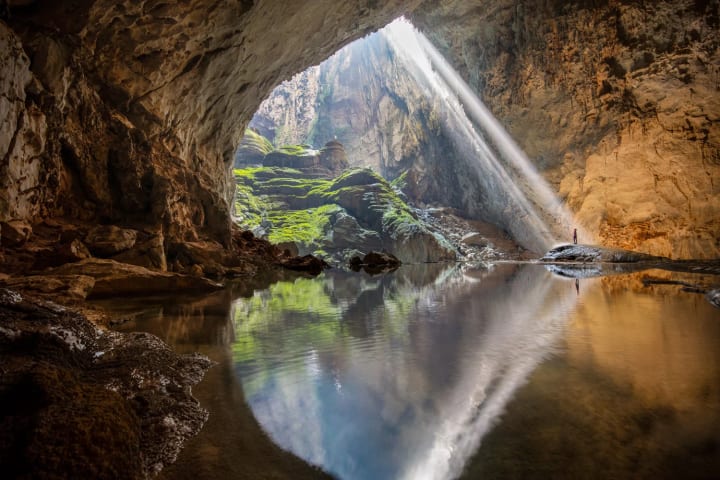
Hang Va
Hang Va is an extremely unique cave of the Phong Nha system that was surveyed by the British-Vietnamese cave exploration team in 2012. It is an underground water cave that experts suspect flows from Son Doong Cave. The cave has a unique stalactite system called cone-shaped stalagmites, which are unique, especially with such large numbers and sizes.
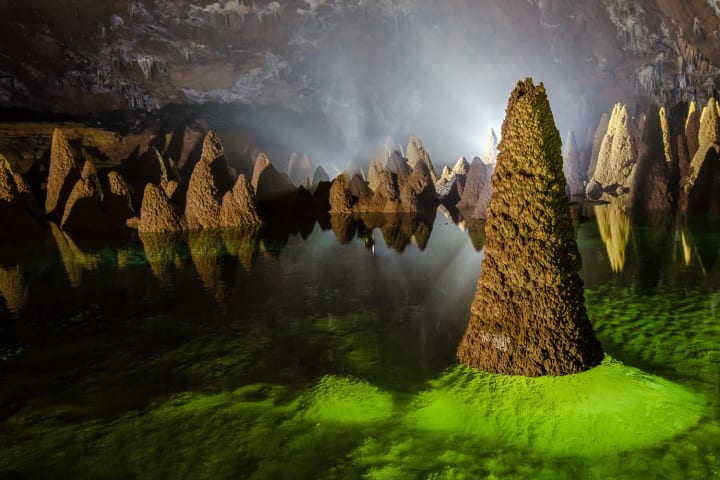
Nuoc Nut Cave
In 2001, the British - Vietnamese cave expedition team discovered Nuoc Nut cave with the help of a local resident (currently a security guard for Oxalis Home). The dry cave entrance leads into a cave with beautiful terrain and stalactite structures and a large underground stream bed. 2.2km long, this stream flows through the cave and sinks into the ground at the end of the cave. The water then emerges and flows above the ground through the Mada valley to enter the Tra Ang river.
Phong Nha Cave
is the last cave in the system and is a unique cave with a long underground river with a total length of up to 11km. Phong Nha Cave was conducted expeditions, surveys and measurements by members of the Anglo-Vietnamese Cave Exploration Group in 1990 and 1992.
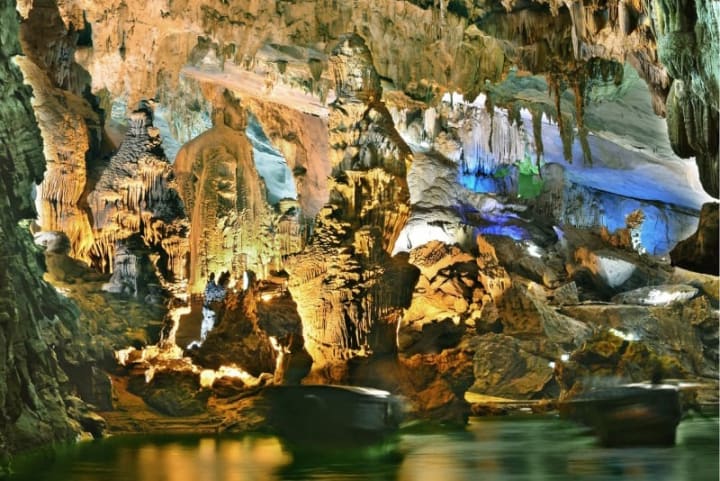
Hoa Huong Cave
Hoa Huong Cave was surveyed in 2012 and 2016. This cave has a total length of 3910m and a depth of 118m. The rock bed that the geological fault passes through to create Hoa Huong Cave is about 251 - 360 million years old. Besides, Hoa Huong Cave is estimated to be about 5 million years old, making it the oldest cave in the Phong Nha system.
The caves belong to the Hang Vom system
According to cave experts, the Hang Vom system is probably the greatest cave system in Vietnam and possibly the world in terms of scale and splendor. This system has about 70 caves that have been surveyed with a total length of more than 48km. This is also a water cave of significant scale in the Phong Nha - Ke Bang limestone block. This system starts from Ruc Ca Roong Cave located at an altitude of about 300m above sea level. After flowing underground through many caves, the Ca Roong River reappears at Hang Vom and flows into the Chay River, Son River and then into the sea.
Outstanding caves in the Hang Vom system
Dai Cao Cave
The cave is approximately 1.6km long with 3 entrances. This cave was surveyed and measured by experts in the British - Vietnamese Cave Exploration Group in 1994. Dai Cao Cave is an extremely unique combination of water and dry branches. Besides, right at the cave entrance, many footprints of precious and rare animals such as wild boar and chamois were collected.
Me Cung Cave

This is one of the caves discovered and measured by the British - Vietnamese Cave Exploration Group in 1994. This cave is nearly 4km long and has many extremely complex branches, considered by cave experts to be One of the caves has the most complex corridors connected by a main water branch flowing through the cave.
Hang Ba
This is also one of the caves surveyed in 1994 at the same time as Dai Cao Cave. Hang Ba is about 1km long and is described as a cave for true adventurers due to the interesting combination of collapsed rocks and impressive turquoise lakes.
Hang Vom (Upper door is also known as Long Bay Cave)
About 4km from Ho Chi Minh Highway West branch. The cave is more than 15km long and is the largest cave in the Hang Vom System. The cave entrance is 100m wide and 50m high. To enter this cave, you need to swim through a large lake right at the cave entrance. In the cave there is a sinkhole 200m high and 50m wide. In addition, in this system there are also some other typical caves such as Dai A Cave, Over Cave and Pygmy Cave. Dai A Cave, also known as Tiger Cave, is 1,616m long, 46m deep, with a cave entrance about 50m wide. About 100m away from Tiger Cave is Over Cave with a length of 3,244m, a depth of 104m, with a cave entrance about 25m high, about 30m wide and the widest point is 125m. Pygmy Cave is 845m long and 94m deep.

Paradise Cave
Thien Duong Cave is a dry branch of Hang Vom. The entrance to the cave is located at Km16 West Branch of the Ho Chi Minh Trail and belongs to ancient Karst terrain dating back about 350 to 400 million years. Thien Duong Cave has a length of more than 3.5 km; Width ranges from 30 to 100m and the widest place is up to 150m; The height from the cave floor to the ceiling is about 60 - 80m. In addition, the dry branch of this cave is also linked to the water branch of Hang Vom (Long Vinh cave).


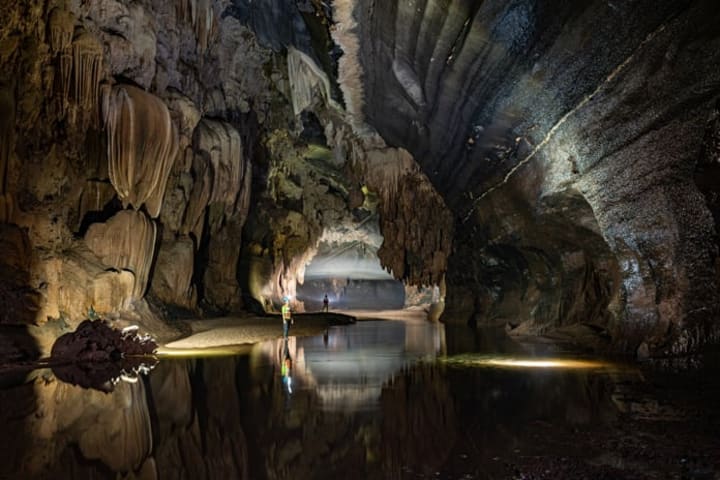
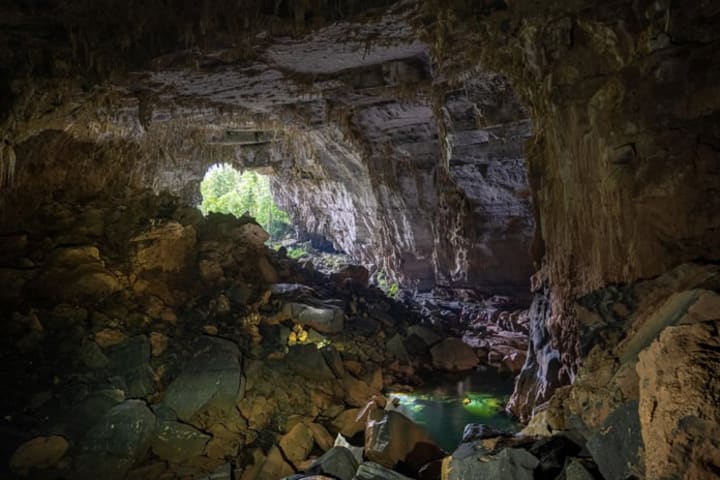
The caves belong to the Nuoc Mooc system
It is a fairly low-lying area, located along the Ho Chi Minh Trail, with Nuoc Mooc stream emerging at the bottom of a majestic Karst hill. Because huge underground water tables sometimes "grow" out of this area, some researchers believe there could be a huge cave system right here that could reach all the way to Laos. This system has more than 50 caves with a total length of more than 20km. This cave system is quite mysterious because the source of the underground stream has not yet been discovered. In addition, the cave entrances are difficult to access because the caves are mainly short underground water caves with relatively dangerous paths. The highlight of this system is Nuoc Mooc Stream with a lake with a spring "growing" with an area of about 90m2. Most of the caves of this system are concentrated mainly near the Mooc Spring area and the West branch of the Chay River, including the Xuong valley (located in the center of the National Park).
Every year, the team of cave experts from the Anglo-Vietnamese Cave Exploration Group continues to survey and measure many other caves in the area. Until now, the Xuong valley and the area around the Ca Roong river still hold a mystery for experts to continue to explore and search for.

About the Creator
Ken aquariums
Telling stories my heart needs to tell <3 life is a journey, not a competition
If you like what you read, feel free to leave a tip,I would love some feedback
https://sites.google.com/view/hk-decor/trang-ch%E1%BB%A7
Enjoyed the story? Support the Creator.
Subscribe for free to receive all their stories in your feed. You could also pledge your support or give them a one-off tip, letting them know you appreciate their work.






Comments (2)
Very inspiring read, thanks for sharing. Please develop it further so I can have more of this interesting knowledge
beautiful.